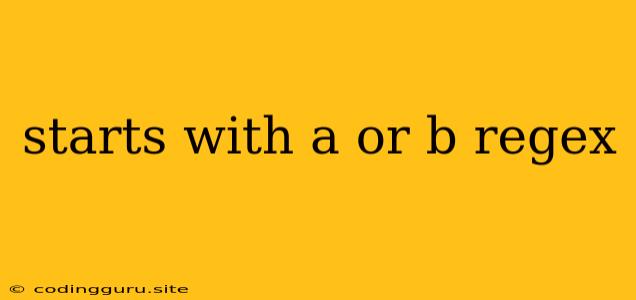Mastering Regular Expressions: Strings Starting with 'a' or 'b'
Regular expressions, often shortened to "regex," are powerful tools for pattern matching in text. They are used extensively in programming languages, text editors, and various data processing tools. One common task is identifying strings that start with specific characters. In this article, we'll explore how to use regex to find strings starting with "a" or "b."
The Fundamental Pattern
The key to achieving this lies in understanding the fundamental pattern:
^[ab]
Let's break it down:
- ^: This symbol represents the beginning of the string. It ensures that the match happens only at the start.
- [ab]: This is a character class. It indicates that the string must start with either an 'a' or a 'b'. The square brackets allow you to specify a range of characters or a set of specific characters.
Practical Examples
1. JavaScript:
const string1 = "apple";
const string2 = "banana";
const string3 = "cherry";
const regex = /^[ab]/;
console.log(regex.test(string1)); // true
console.log(regex.test(string2)); // true
console.log(regex.test(string3)); // false
This JavaScript code demonstrates how to use the regex pattern to check if strings start with "a" or "b." The test() method returns true if the string matches the pattern and false otherwise.
2. Python:
import re
string1 = "apple"
string2 = "banana"
string3 = "cherry"
pattern = r"^[ab]"
match1 = re.match(pattern, string1)
match2 = re.match(pattern, string2)
match3 = re.match(pattern, string3)
print(match1 is not None) # True
print(match2 is not None) # True
print(match3 is not None) # False
In Python, we use the re module to work with regular expressions. The re.match() function attempts to match the pattern at the beginning of the string. If a match is found, it returns a match object; otherwise, it returns None.
Beyond "a" and "b"
The principle of using a character class with the "^" symbol can be applied to any set of characters. For instance, you could use ^[A-Za-z] to match strings starting with any uppercase or lowercase letter, or ^[0-9] to match strings starting with a digit.
Tips for Effective Regex Use
- Use online regex testers: Tools like regex101.com allow you to experiment with different patterns and see how they match against your input text.
- Be specific: Clearly define what you want to match. Avoid overly broad patterns that might result in unintended matches.
- Escape special characters: Characters like "." and "*" have special meanings in regex. If you want to match them literally, you need to escape them with a backslash (e.g., ".").
Conclusion
Regular expressions are incredibly versatile for text manipulation and pattern matching. Understanding how to use character classes and anchors like "^" can empower you to efficiently filter and extract information from text data. This specific pattern, ^[ab], is a building block for more complex regex expressions, allowing you to create custom solutions for your unique needs.
